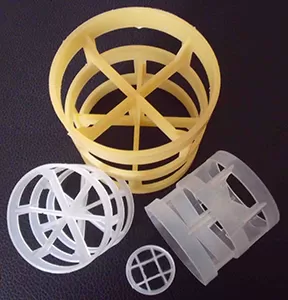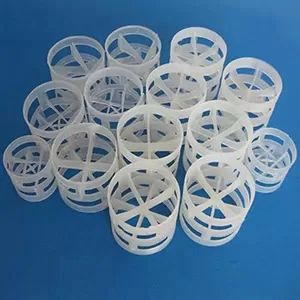Plastic
pall ring packing segmentation is crucial for ensuring efficient operation in industrial processes. This article will explore the specific requirements for segmenting plastic Pall ring packing.
The height of each segment is a key requirement. Generally, the height of each segment of plastic Pall ring packing should be controlled within a certain range, typically between 0.5 meters and 1.5 meters. This range is determined based on the need to balance mass transfer efficiency and operational stability. If the segment height is too low, the number of segments increases, which may lead to more complex installation and increased pressure drop. Conversely, an excessively high segment can cause uneven distribution of fluids, reducing mass transfer efficiency and potentially leading to channeling, where fluids flow through preferential paths rather than uniformly contacting the packing.

Stability between segments is another important consideration. Each segment of plastic Pall ring packing must be properly supported to prevent shifting or collapse during operation. Support grids or plates are commonly used to separate and support each segment, ensuring that the weight of the packing is evenly distributed. These supports must be strong enough to withstand the total weight of the packing above, including any additional loads from fluid flow. Additionally, the connection between segments should be tight to avoid gaps that could disrupt fluid flow and create dead zones.

Uniform distribution of fluids across each segment is essential. The design of the segmentation should facilitate even distribution of both liquid and gas phases throughout the packing. This often involves the use of liquid distributors between segments to redistribute the liquid, ensuring that it spreads evenly over the surface of the next segment. Without proper redistribution, liquid may accumulate in certain areas of the packing, reducing the effective contact area and lowering mass transfer efficiency. Gas distributors may also be required in some cases to ensure that gas flows uniformly through each segment, preventing localized high or low velocities that could disrupt the packing bed.
Compatibility with the equipment dimensions is a basic requirement. The segmentation of plastic Pall ring packing must align with the internal diameter and height of the column or tower where it is installed. The segments should fit snugly within the equipment to avoid annular gaps between the packing and the vessel wall, which can cause bypassing of fluids and reduce efficiency. Careful measurement and calculation are needed to determine the number of segments and their respective heights based on the equipment's specifications, ensuring a proper fit and optimal use of the available space.
Consideration of maintenance and inspection is also part of the segmentation requirements. Segments should be designed to allow easy access for inspection, cleaning, and replacement of the packing. This may involve designing segments that can be removed individually without disturbing the entire packing bed. Additionally, the spacing between segments should provide sufficient room for personnel or tools to enter and perform maintenance tasks, ensuring that any issues with the packing can be addressed promptly to minimize downtime.
In summary, the segmentation of plastic Pall ring packing requires careful attention to segment height, stability, fluid distribution, equipment compatibility, and maintenance access. Adhering to these requirements ensures that the packing operates efficiently, with high mass transfer rates and long-term reliability in industrial processes.



